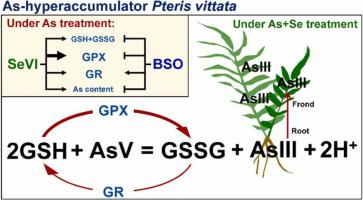Journal of Hazardous Materials ( IF 12.2 ) Pub Date : 2021-10-23 , DOI: 10.1016/j.jhazmat.2021.127581 Zhi-Hua Dai 1 , Song Ding 1 , Jia-Yi Chen 1 , Ran Han 1 , Yue Cao 2 , Xue Liu 3 , Shuxin Tu 4 , Dong-Xing Guan 1 , Lena Q Ma 1

|
The beneficial effects of selenium on As uptake and plant growth in As-hyperaccumulator Pteris vittata are known, but the associated mechanisms remain unclear. Here, we investigated the effects of selenate on arsenic accumulation by P. vittata under two arsenate levels. P. vittata plants were exposed to 13 (As13) or 133 µM (As133) arsenate and 5 µM selenate in 0.2-strength Hoagland solution. After 14 d of growth, plant biomass, Se and As content, As speciation, and malondialdehyde (MDA), glutathione reductase (GR), glutathione peroxidase (GPX), and glutathione (GSH and GSSG) levels were determined. The results show that selenate promoted P. vittata growth and increased As concentrations in the roots and fronds by 256% from 97 to 346 mg kg−1 and 142% from 213 to 514 mg kg−1 under As13 treatment, and by 166% from 500 to 1332 mg kg−1 and 534% from 777 to 4928 mg kg−1 under As133 treatment. In addition, selenate increased the glutathione content in P. vittata roots and fronds by 75–86% under As13 treatment and 44–45% under As133 treatment. Selenate also increased the GPX activity by 161–173%, and GR activity by 72–79% in P. vittata under As13 and As133 treatments. The HPLC-ICP-MS analysis indicated that selenate increased both AsIII and AsV levels in P. vittata, with AsIII/AsV ratio being lower in the roots and higher in the fronds, i.e., more AsIII was being translocated to the fronds. Taken together, our results suggest that, via GPX-GR mediated enhancement of GSH-GSSG cycle, selenate effectively increases plant growth and As uptake in P. vittata by improving AsV reduction in the roots and AsIII translocation from the roots to the fronds.
中文翻译:

硒酸盐通过谷胱甘肽增强的砷还原和易位增加了 As-hypercumulator Pteris vittata 的植物生长和砷吸收
硒对 As-hypercumulator Pteris vittata中 As 吸收和植物生长的有益影响是已知的,但相关机制仍不清楚。在这里,我们研究了硒酸盐在两种砷酸盐水平下对P. vittata砷积累的影响。P. vittata植物在 0.2 浓度的 Hoagland 溶液中暴露于 13 (As 13 ) 或 133 µM (As 133 ) 砷酸盐和 5 µM 硒酸盐。生长 14 天后,测定植物生物量、Se 和 As 含量、As 形态和丙二醛 (MDA)、谷胱甘肽还原酶 (GR)、谷胱甘肽过氧化物酶 (GPX) 和谷胱甘肽 (GSH 和 GSSG) 水平。结果表明,硒酸盐促进了P. vittata在 As 13处理下,根和叶中的 As 浓度从 97 到 346 mg kg -1增加了 256%,从 213 到 514 mg kg -1增加了 142% ,从 500 到 1332 mg kg -1增加了 166%和在 As 133处理下,534% 从 777 到 4928 mg kg -1 。此外,在 As 13 处理下,硒酸盐使 P. vittata 根和叶中的谷胱甘肽含量增加了75-86 %,在 As 133处理下增加了 44-45% 。在 As 13和 As 133下,硒酸盐还将P. vittata中的 GPX 活性提高了 161-173%,GR 活性提高了 72-79%治疗。HPLC-ICP-MS 分析表明,硒酸盐增加了P. vittata中AsIII 和AsV 的含量,AsIII/AsV 比值在根中较低而在叶中较高,即更多的AsIII 被转移到叶中。总之,我们的结果表明,通过 GPX-GR 介导的 GSH-GSSG 循环增强,硒酸盐通过改善根中 AsV 的减少和 AsIII 从根到叶的易位,有效地增加了植物生长和P. vittata对 As 的吸收。











































 京公网安备 11010802027423号
京公网安备 11010802027423号